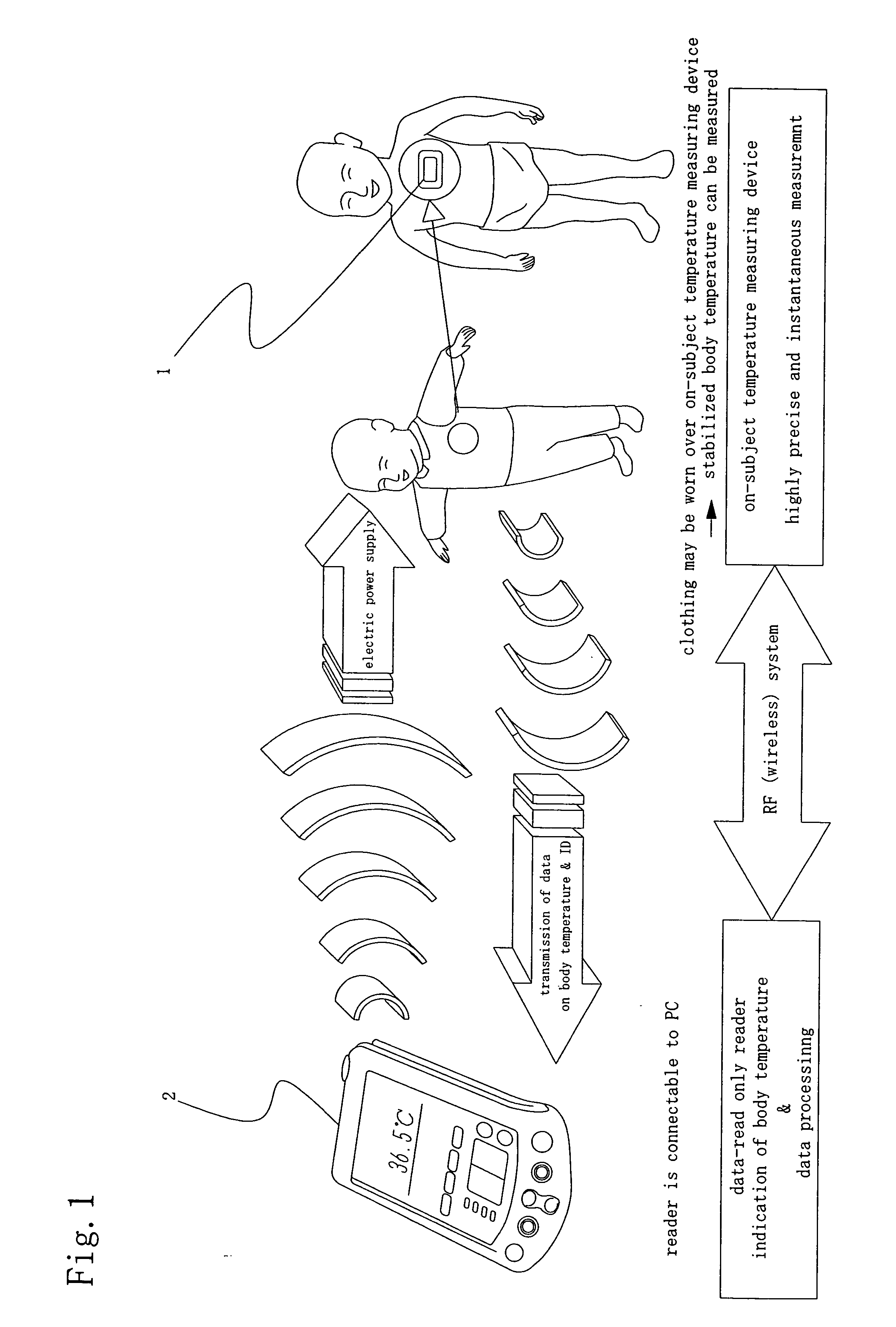Temperature measuring device and temperature measuring method
- Summary
- Abstract
- Description
- Claims
- Application Information
AI Technical Summary
Benefits of technology
Problems solved by technology
Method used
Image
Examples
first embodiment
[0061]FIG. 1 is an overall schematic view of a temperature measuring system to which a first embodiment of the temperature measuring device according to the present invention is applied.
[0062] Referring to FIG. 1, an on-subject temperature measuring device 1 as a temperature measuring device, which is attached to a subject when a temperature of the subject is measured, receives a radio wave from a reader 2 as an external device and is thereby electrically powered. By means of the electric power, temperature measurement is performed in the on-subject temperature measuring device 1. The results of the measurement are transmitted through radio waves to the reader 2 as a temperature of the subject and ID data. The reader 2 is so constructed as to be connectable to a personal computer (not shown), and data processing by the personal computer is performed according to need.
[0063]FIG. 2 is an overall schematic view schematically representing the temperature measuring system, to which the...
second embodiment
[0101] In a temperature measuring system to which a second embodiment of the temperature measuring device according to the present invention is applied, a circuit element of an on-subject temperature measuring device 1 comprises no CPU or A / D converter, as different from the first embodiment. Instead thereof, an oscillation circuit is provided for producing oscillations with frequencies proportional to resistance values of a chip thermistor or film type thermistor, and a radio wave with such an oscillation frequency or a period (pulse width) of the frequency is directly transmitted as data to a reader 2 as an external device, and the frequency or period is converted into temperature data by a software in the external device. In this embodiment, the circuitry is simplified. This enables the temperature measuring system to be one to which such an inexpensive temperature measuring device is applied.
third embodiment
[0102]FIG. 15 is a bottom view of a third embodiment of the on-subject temperature measuring device according to the present invention. FIG. 16 is a bottom view of another form of the third embodiment of the temperature measuring device according to the present invention. FIG. 17 is still another form of the third embodiment of the temperature measuring device according to the present invention. Difference between the third embodiment and the first embodiment resides in that a sheet 24 with an adhesive is used in the third embodiment of the temperature measuring device, and the sheet 24 with an adhesive is applied to a nonwoven fabric 19 which is attached to a film-form control substrate 18, and a space within an opening 20 of the nonwoven fabric 19 is thereby sealed as shown in the Figs. In the form shown in FIG. 15, a rectangular air communication hole 25 is provided at a predetermined position of the sheet 24 with an adhesive. The air communication hole 25 may be circular. In the...
PUM
 Login to View More
Login to View More Abstract
Description
Claims
Application Information
 Login to View More
Login to View More - R&D
- Intellectual Property
- Life Sciences
- Materials
- Tech Scout
- Unparalleled Data Quality
- Higher Quality Content
- 60% Fewer Hallucinations
Browse by: Latest US Patents, China's latest patents, Technical Efficacy Thesaurus, Application Domain, Technology Topic, Popular Technical Reports.
© 2025 PatSnap. All rights reserved.Legal|Privacy policy|Modern Slavery Act Transparency Statement|Sitemap|About US| Contact US: help@patsnap.com



